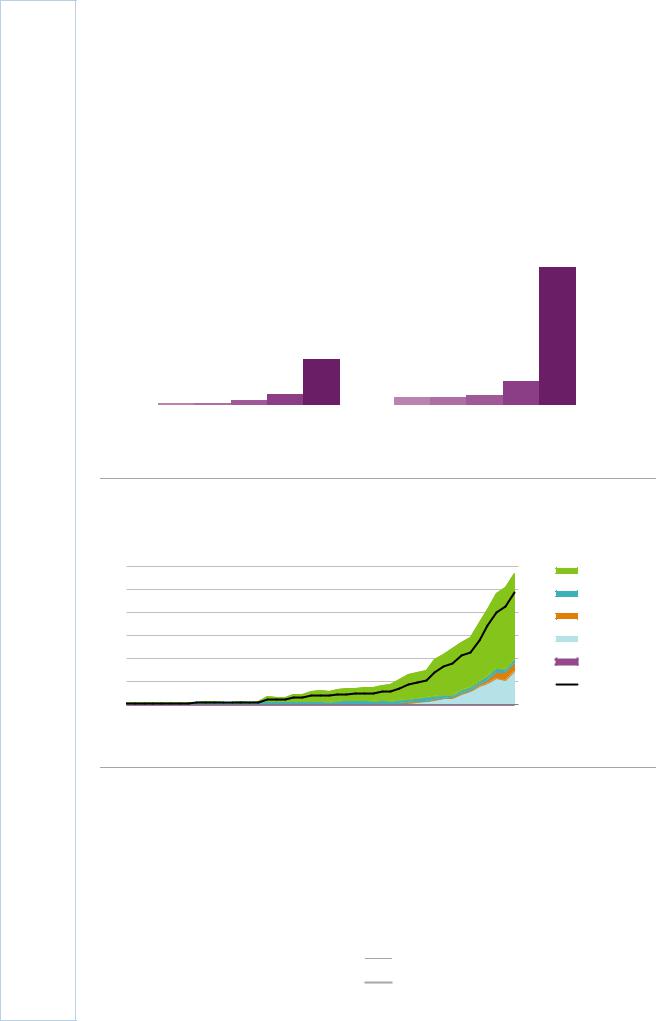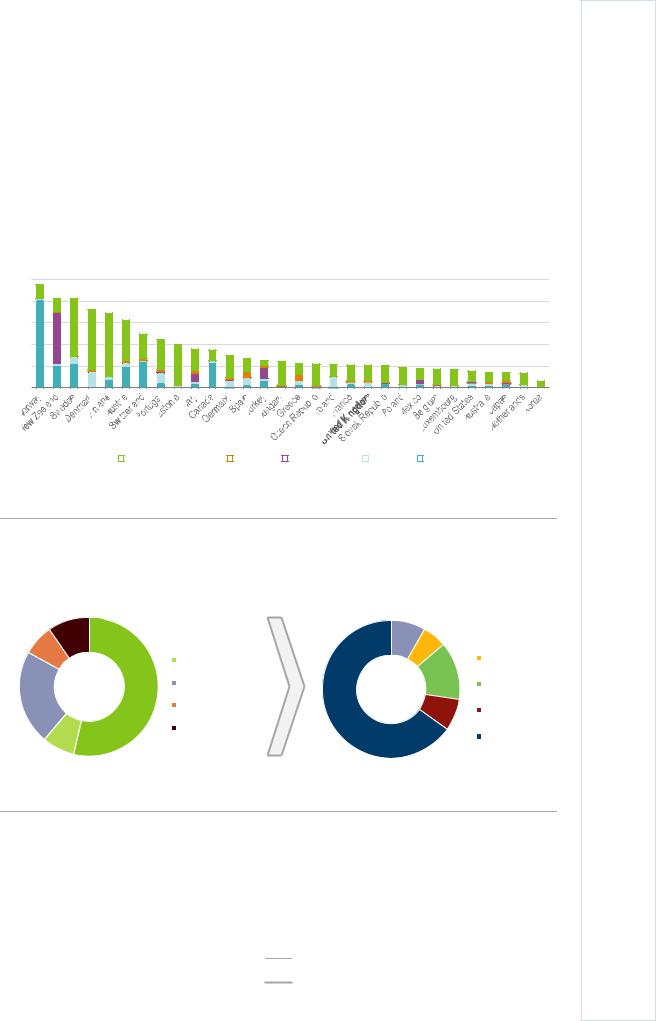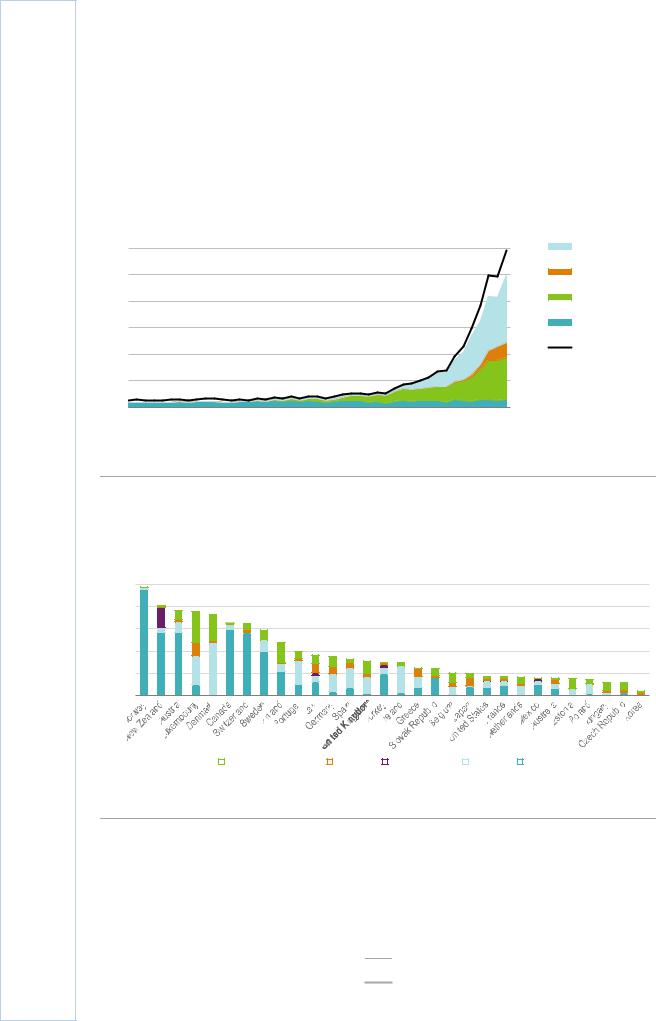
- •Foreword
- •Table of contents
- •Figures
- •Tables
- •Boxes
- •1. Executive summary
- •Energy system transformation
- •Special focus 1: The cost-effectiveness of climate measures
- •Special focus 2: The Electricity Market Reform
- •Special focus 3: Maintaining energy security
- •Key recommendations
- •2. General energy policy
- •Country overview
- •Institutions
- •Supply and demand trends
- •Primary energy supply
- •Energy production
- •Energy consumption
- •Energy policy framework
- •Energy and climate taxes and levies
- •Assessment
- •Recommendations
- •3. Energy and climate change
- •Overview
- •Emissions
- •GHG emissions
- •Projections
- •Institutions
- •Climate change mitigation
- •Emissions targets
- •Clean Growth Strategy
- •The EU Emissions Trading System
- •Low-carbon electricity support schemes
- •Climate Change Levy
- •Coal phase-out
- •Energy efficiency
- •Low-carbon technologies
- •Adaptation to climate change
- •Legal and institutional framework
- •Evaluation of impacts and risks
- •Response measures
- •Assessment
- •Recommendations
- •4. Renewable energy
- •Overview
- •Supply and demand
- •Renewable energy in the TPES
- •Electricity from renewable energy
- •Heat from renewable energy
- •Institutions
- •Policies and measures
- •Targets and objectives
- •Electricity from renewable energy sources
- •Heat from renewable energy
- •Renewable Heat Incentive
- •Renewable energy in transport
- •Assessment
- •Electricity
- •Transport
- •Heat
- •Recommendations
- •5. Energy efficiency
- •Overview
- •Total final energy consumption
- •Energy intensity
- •Overall energy efficiency progress
- •Institutional framework
- •Energy efficiency data and monitoring
- •Regulatory framework
- •Energy Efficiency Directive
- •Other EU directives
- •Energy consumption trends, efficiency, and policies
- •Residential and commercial
- •Buildings
- •Heat
- •Transport
- •Industry
- •Assessment
- •Appliances
- •Buildings and heat
- •Transport
- •Industry and business
- •Public sector
- •Recommendations
- •6. Nuclear
- •Overview
- •New nuclear construction and power market reform
- •UK membership in Euratom and Brexit
- •Waste management and decommissioning
- •Research and development
- •Assessment
- •Recommendations
- •7. Energy technology research, development and demonstration
- •Overview
- •Energy research and development strategy and priorities
- •Institutions
- •Funding on energy
- •Public spending
- •Energy RD&D programmes
- •Private funding and green finance
- •Monitoring and evaluation
- •International collaboration
- •International energy innovation funding
- •Assessment
- •Recommendations
- •8. Electricity
- •Overview
- •Supply and demand
- •Electricity supply and generation
- •Electricity imports
- •Electricity consumption
- •Institutional and regulatory framework
- •Wholesale market design
- •Network regulation
- •Towards a low-carbon electricity sector
- •Carbon price floor
- •Contracts for difference
- •Emissions performance standards
- •A power market for business and consumers
- •Electricity retail market performance
- •Smart grids and meters
- •Supplier switching
- •Consumer engagement and vulnerable consumers
- •Demand response (wholesale and retail)
- •Security of electricity supply
- •Legal framework and institutions
- •Network adequacy
- •Generation adequacy
- •The GB capacity market
- •Short-term electricity security
- •Emergency response reserves
- •Flexibility of the power system
- •Assessment
- •Wholesale electricity markets and decarbonisation
- •Retail electricity markets for consumers and business
- •The transition towards a smart and flexible power system
- •Recommendations
- •Overview
- •Supply and demand
- •Production, import, and export
- •Oil consumption
- •Retail market and prices
- •Infrastructure
- •Refining
- •Pipelines
- •Ports
- •Storage capacity
- •Oil security
- •Stockholding regime
- •Demand restraint
- •Assessment
- •Oil upstream
- •Oil downstream
- •Recommendations
- •10. Natural gas
- •Overview
- •Supply and demand
- •Domestic gas production
- •Natural gas imports and exports
- •Largest gas consumption in heat and power sector
- •Natural gas infrastructure
- •Cross-border connection and gas pipelines
- •Gas storage
- •Liquefied natural gas
- •Policy framework and markets
- •Gas regulation
- •Wholesale gas market
- •Retail gas market
- •Security of gas supply
- •Legal framework
- •Adequacy of gas supply and demand
- •Short-term security and emergency response
- •Supply-side measures
- •Demand-side measures
- •Gas quality
- •Recent supply disruptions
- •Interlinkages of the gas and electricity systems
- •Assessment
- •Recommendations
- •ANNEX A: Organisations visited
- •Review criteria
- •Review team and preparation of the report
- •Organisations visited
- •ANNEX B: Energy balances and key statistical data
- •Footnotes to energy balances and key statistical data
- •ANNEX C: International Energy Agency “Shared Goals”
- •ANNEX D: Glossary and list of abbreviations
- •Acronyms and abbreviations
- •Units of measure

4. RENEWABLE ENERGY
Supply and demand
Renewable energy supply has increased significantly in the United Kingdom over the past decade. The share of renewable energy in the total primary energy supply (TPES) has grown from 2% in 2007 to 10% in 2017 and its share in electricity generation increased from 5% to 30% (Figure 4.1).
Figure 4.1 Share of renewable energy in TPES and electricity generation,
1977-2017 |
|
|
|
|
||
35% |
|
|
|
|
1977 |
|
|
|
|
|
|||
30% |
|
|
|
|||
|
|
|
|
1987 |
||
|
|
|
||||
|
|
|||||
|
|
|
||||
25% |
|
|
|
1997 |
||
|
|
|||||
|
|
|
|
2007 |
||
20% |
|
|
|
|||
|
|
|||||
|
|
|||||
|
|
|
|
2017 |
||
|
|
|
|
|||
15% |
|
|
|
|||
|
|
|||||
|
|
|
|
|
||
|
|
|
|
|
||
10% |
|
|
|
|
|
|
|
|
|
|
|
||
5% |
|
|
|
|
|
|
|
|
|
|
|
||
0% |
|
|
|
|
|
|
TPES |
Electricity generation |
|||||
|
||||||
In the past decade, the United Kingdom has sharply increased the share of renewable energy in its primary energy supply and electricity generation.
Source: IEA (2019), World Energy Balances 2019 First edition (database), www.iea.org/statistics/.
Figure 4.2 Renewable energy and waste in TPES, 1990-2017
18 |
Mtoe |
|
|
|
|
|
|
|
|
|
|
12% |
Bioenergy* |
|
|
|
|
|
|
|
|
|
|
|
|||
|
|
|
|
|
|
|
|
|
|
|
|
|
|
15 |
|
|
|
|
|
|
|
|
|
|
|
10% |
Hydro |
|
|
|
|
|
|
|
|
|
|
|
|
|
|
12 |
|
|
|
|
|
|
|
|
|
|
|
8% |
Solar |
|
|
|
|
|
|
|
|
|
|
|
|
|
|
9 |
|
|
|
|
|
|
|
|
|
|
|
6% |
Wind |
6 |
|
|
|
|
|
|
|
|
|
|
|
4% |
Geothermal** |
3 |
|
|
|
|
|
|
|
|
|
|
|
2% |
Renewables share |
0 |
|
|
|
|
|
|
|
|
|
|
|
0% |
(right axis) |
|
|
|
|
|
|
|
|
|
|
|
|
||
1973 |
1977 |
1981 |
1985 |
1989 |
1993 |
1997 |
2001 |
2005 |
2009 |
2013 |
2017 |
|
|
Bioenergy and waste is the largest RES in the primary energy supply.
*Bioenergy includes primary solid biofuels, liquid biofuels, biogases and renewable municipal waste.
**Negligible.
Source: IEA (2019), World Energy Balances 2019 First edition (database), www.iea.org/statistics/.
Renewable energy in the TPES
In 2017, the supply of renewable energy in the United Kingdom was 17.1 million tonnes of oil-equivalent (Mtoe), 9.7% of the TPES. The share of renewable energy in the TPES has increased since the 1990s, mostly thanks to the rapid increase of bioenergy and waste supply; the growth has been particularly remarkable since 2009 (Figure 4.2).
56
IEA. All rights reserved.

4. RENEWABLE ENERGY
Nevertheless, the United Kingdom has the eleventh lowest share of renewable energy in the TPES among the International Energy Agency (IEA) member countries (Figure 4.3). Bioenergy and waste was the largest source of renewable energy in TPES at 7.1% (including 1.2 Mtoe non-renewable waste). Bioenergy and waste includes primary solid biofuels (54%), biogas (22%), wastes (17%), and transport biofuels (7%) (Figure 4.4). Energy transformation accounts for nearly two-thirds of the biofuel and waste demand, followed by the residential and industry sectors. The second-largest renewable energy is wind, with 2.4% in the TPES in 2017.
Figure 4.3 Renewable energy and waste as a percentage of the TPES in IEA member countries, 2017
50% |
40% |
30% |
20% |
10% |
0% |
|
Biofuels and waste |
|
Solar |
|
Geothermal |
|
Wind |
|
Hydro |
|
|
|
|
|
|||||
|
|
|
|
|
The United Kingdom has the eleventh lowest share of renewable energy in TPES among IEA member countries.
Note: Includes non-renewable waste.
Source: IEA (2019), World Energy Balances 2019 First edition (database), www. |
|
|
|
. |
|
|
|||||
|
|
|
|
|
|
|
|
|
|
||
Figure 4.4 Bioenergy and waste supply by source and |
|
|
sector, 2017 |
||||||||
10% |
|
|
Primary solid biofuels |
|
|
8% |
6% |
|
|
|
Industry |
|
|
|
|
|
|
|
|||||
|
|
|
|
|
|
|
|
||||
7% |
|
|
Liquid biofuels* |
|
|
|
|
|
|
Commercial |
|
|
|
|
|
|
|
|
|
|
|
||
22% |
|
|
Biogases |
|
|
|
14% |
|
|
Residential |
|
54% |
|
|
|
|
|
|
|
|
|||
|
|
|
|
|
|
|
|
|
|
||
|
|
Renewable waste |
|
|
|
7% |
|
|
|
|
|
|
|
|
65% |
|
|
|
|
|
Transport |
||
7% |
|
|
Non-renewable |
|
|
|
|
|
|
|
Energy |
|
|
waste |
|
|
|
|
|
|
|
||
|
|
|
|
|
|
|
|
|
|
||
|
|
|
|
|
|
|
|
|
|
|
transformation** |
In 2017, primary solid biofuels accounted for over half of bioenergy and waste, and around two-thirds of bioenergy and waste were used in heat and power generation.
*Includes biodiesel and biogasoline, e.g. fuel ethanol.
**Energy transformation is mainly electricity and heat generation from primary solid biofuels and wastes. Source: IEA (2019), World Energy Balances 2019 First edition (database), www.iea.org/statistics/.
57
ENERGY SYSTEM TRANSFORMATION
IEA. All rights reserved.

4. RENEWABLE ENERGY
Electricity from renewable energy
The share of renewable electricity has increased significantly. In 2018, the total installed capacity of variable renewable energy was 32.7 gigawatts (GW), of which 61% was wind and 39% solar photovoltaics (PV). In 2017, renewable energy generated 99 terrawatt hours (TWh), which accounted for 30% of the total electricity generation, up from 5% in 2007 (Figure 4.5). This places the United Kingdom at the median share of renewables in electricity generation among IEA countries (Figure 4.6).
Figure 4.5 Renewable energy and waste in electricity generation, 1990-2017
120 |
TWh |
|
|
|
|
|
|
|
|
|
|
30% |
Wind |
|
|
|
|
|
|
|
|
|
|
|
|||
100 |
|
|
|
|
|
|
|
|
|
|
|
25% |
Solar |
80 |
|
|
|
|
|
|
|
|
|
|
|
20% |
Bioenergy* |
|
|
|
|
|
|
|
|
|
|
|
|
||
60 |
|
|
|
|
|
|
|
|
|
|
|
15% |
Hydro |
|
|
|
|
|
|
|
|
|
|
|
|
||
40 |
|
|
|
|
|
|
|
|
|
|
|
10% |
Renewables share |
|
|
|
|
|
|
|
|
|
|
|
(right axis) |
||
|
|
|
|
|
|
|
|
|
|
|
|
|
|
20 |
|
|
|
|
|
|
|
|
|
|
|
5% |
|
0 |
|
|
|
|
|
|
|
|
|
|
|
0% |
|
1973 |
1977 |
1981 |
1985 |
1989 |
1993 |
1997 |
2001 |
2005 |
2009 |
2013 |
2017 |
|
|
Renewable energies have shown considerable growth, particularly wind and bioenergy and waste, and accounted for 31% of the total electricity generation in 2017.
* Includes primary solid biofuels, liquid biofuels, biogases and renewable municipal waste. Source: IEA (2019), World Energy Balances 2019 First edition (database), www.iea.org/statistics/.
Figure 4.6 Renewable energy as a percentage of electricity generation in IEA member countries, 2017
100% |
80% |
60% |
40% |
20% |
0% |
|
Biofuels and waste |
|
Solar |
|
Geothermal |
|
Wind |
|
Hydro |
|
|
|
|
|
|||||
|
|
|
|
|
The United Kingdom’s share of renewable energy in electricity generation is around the median in the IEA.
Note: Includes non-renewable waste.
Source: IEA (2019), World Energy Balances 2019 First edition (database), www.iea.org/statistics/.
Wind is the largest source of renewable electricity with 14.9% of the total electricity generation in 2017 and wind generation is expected to increase strongly until 2020 at an average annual growth rate of around 13%. The total wind power generation has increased from 5.3 TWh in 2007 to 50.0 TWh in 2017.
58
IEA. All rights reserved.
